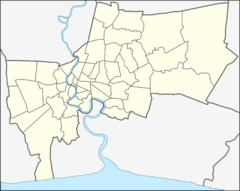| This article needs additional citations for verification. Please help improve this article by adding citations to reliable sources. Unsourced material may be challenged and removed. Find sources: "Wat Apson Sawan" – news · newspapers · books · scholar · JSTOR (March 2021) (Learn how and when to remove this message) |
| Wat Apson Sawan | |
|---|---|
| Wat Mu | |
 The ancient ho trai The ancient ho trai | |
| Religion | |
| Affiliation | Buddhism |
| Sect | Theravāda |
| Location | |
| Location | 174 Thoet Thai Rd., Pak Khlong Phasi Charoen, Phasi Charoen, Bangkok |
| Country | Thailand |
 | |
| Geographic coordinates | 13°43′12″N 100°28′11″E / 13.71988°N 100.469857°E / 13.71988; 100.469857 |
| Architecture | |
| Founder | Chinese Wu |
Wat Apson Sawan Worawihan (Thai: วัดอัปสรสวรรค์วรวิหาร), also simply known as Wat Apson Sawan is an ancient Thai Buddhist temple more than 200 years in Bangkok. It is situated rim canal Khlong Dan bounded by other temple were famed Wat Paknam Bhasicharoen, Wat Nang Chi, and across the canal is Wat Khun Chan in Talat Phlu quarter.
The temple is third classed royal monastery in Worawihan type. Formerly it was called Wat Mu (วัดหมู, "pig temple"), as it was built on the land of pig stable and the pigs were allowed to stroll in the compound, and was told that the temple was built by a Chinese named Wu (悟) without evidence of when it was created. Later on, during the reign of King Nangklao (Rama III), Royal Concubine Noi (Suranakong) has restored the temple. Later, King Nangklao ordered the temple renovated once again and bestowed the name "Wat Apson Sawan" ("temple of celestial apsara") to the temple.
What is interesting about this temple include ubosot (ordination hall) and vihāra (sanctuary) were built in Chinese style like neighbouring Wat Nang Chi. Enshrined inside ubosot are 28 in similar shape and size principal Buddha images in Māravijaya posture created by order of King Nangklao, as well as ho trai (Tripiṭaka hall) a whole wooden library built with Ayutthaya period art in the middle of a pond.
Wat Apson Sawan was declared a national historic site by the Fine Arts Department in 1977.
Gallery
-
 The ordination hall
The ordination hall
-
 28 principal Buddha images
28 principal Buddha images
-
 Stūpa
Stūpa
References
- "วัดอัปสรสวรรค์วรวิหาร" [Wat Apson Sawan Worawihan]. TAT (in Thai).
- ERRORLLOYD (2020-07-28). "ตามหามรดกที่ซ่อนตัวในกรุงรัตนโกสินทร์ ณ วัดอัปสรสวรรค์วรวิหาร (วัดหมู) ริมคลองภาษีเจริญ" [Finding hidden gem in Rattanakosin at Wat Apson Sawan Worawihan (Wat Mu) rim Khlong Phasi Charoen] (in Thai). Retrieved 2021-03-16.